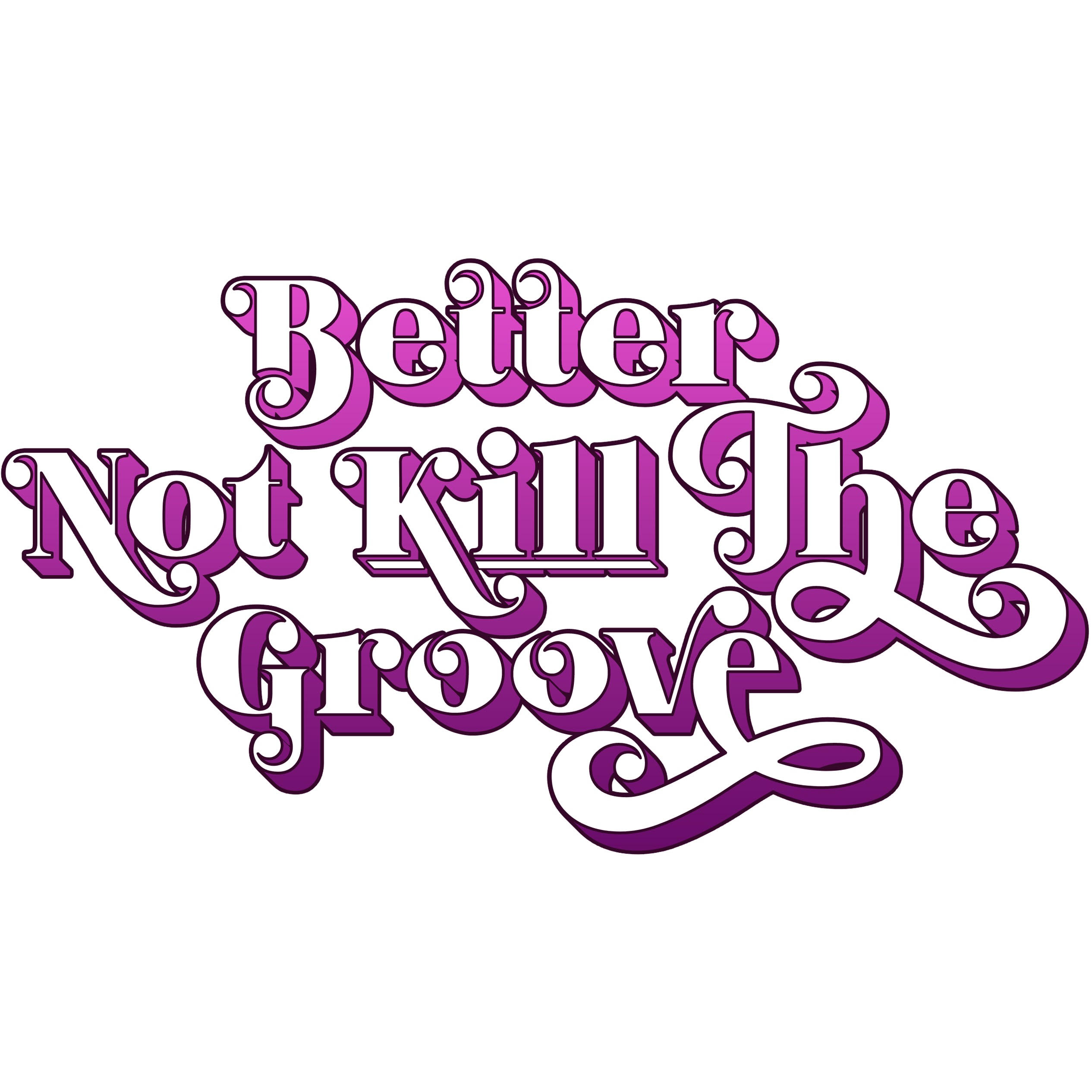Better Not Kill The Grove: A Deep Dive Into The Art Of Groove And Why It Matters
Ever wondered why some songs just stick to your soul? It's all about the groove, baby. The groove is that magical element that makes you move, feel, and connect with music on a deeper level. But here's the thing—killing the groove can ruin the magic. So, let's talk about why it's better not to kill the groove and how you can keep it alive in your life and music.
Music is more than just notes and lyrics; it's a feeling, a vibe, a connection. And at the heart of that connection lies the groove. Think of the groove as the heartbeat of a song. Without it, the music loses its soul, its rhythm, and its ability to make you feel alive. In this article, we'll explore what the groove really means, why it's so important, and how to keep it thriving in your world.
Whether you're a musician, a music lover, or someone who just enjoys a good jam session, understanding the power of groove can change the way you experience music. So, buckle up, because we're about to dive deep into the art of groove and why it's better not to kill it.
- Drew Bledsoe Net Worth The Untold Story Behind The Numbers
- Victory Brinker Net Worth A Closer Look At Her Journey Lifestyle And Financial Success
What Does "Better Not Kill the Grove" Even Mean?
Let's break it down, shall we? The phrase "better not kill the groove" essentially means preserving the essence of what makes music compelling and engaging. It's about respecting the rhythm, the flow, and the emotional connection that music creates. Killing the groove could mean overproducing a track, losing the natural feel of a performance, or simply missing the point of what makes music special.
For instance, imagine a live band playing a soulful jazz tune. The groove is there, alive and kicking, until someone decides to add an over-the-top drum solo that disrupts the flow. That's killing the groove, and it's a big no-no. The groove is delicate, and it needs to be nurtured, not destroyed.
Why Groove Matters in Music
Groove is the backbone of music. It's what makes people dance, tap their feet, and lose themselves in the moment. Without groove, music becomes just noise, lacking the emotional depth and connection that makes it memorable. Here are a few reasons why groove matters:
- Jay Sean Tracks The Ultimate Guide To His Iconic Music Journey
- Warrant Singer The Voice That Shook The 90s
- Emotional Connection: Groove creates an emotional bond between the listener and the music. It's what makes you feel the music, not just hear it.
- Rhythmic Flow: Groove establishes a rhythm that keeps the music moving forward. It's the heartbeat of the song, driving the energy and momentum.
- Universal Appeal: Groove transcends language and culture. It's a universal language that anyone can understand and appreciate.
Understanding the Science Behind Groove
Believe it or not, there's actual science behind why groove works. Research shows that when we listen to music with a strong groove, our brains release dopamine, the "feel-good" neurotransmitter. This is why groovy music makes us happy and energized. It's like a natural high!
Moreover, groove activates the motor areas of our brain, making us want to move and dance. It's a primal response that connects us to the music on a physical level. So, the next time you find yourself swaying to a funky bassline, you can thank your brain for that.
Key Elements of a Groovy Track
Not all music has groove, and not all grooves are created equal. Here are some key elements that make a track truly groovy:
- Rhythm: A steady and consistent rhythm is crucial for maintaining the groove. Think of it as the foundation of the song.
- Basslines: Basslines are the backbone of groove. They provide the low-end punch that makes you feel the music in your bones.
- Syncopation: Syncopation adds complexity and interest to the groove, making it more engaging and dynamic.
How to Create Groove in Your Music
Creating groove isn't just about playing the right notes; it's about feeling the music and letting it flow naturally. Here are some tips for musicians and producers looking to enhance their groove:
First off, focus on the rhythm section. The drums and bass are the driving forces behind the groove. Make sure they're tight and in sync. Next, experiment with syncopation and off-beat rhythms to add depth and interest. And finally, don't be afraid to let go and let the music take you where it wants to go. Sometimes, the best grooves happen when you least expect them.
Common Mistakes That Kill the Groove
As much as we love groove, there are certain things that can kill it faster than you can say "disco." Here are some common mistakes to avoid:
- Overproduction: Too much processing and effects can strip a song of its natural feel and authenticity.
- Inconsistent Timing: If the rhythm section isn't tight, the groove will suffer. Make sure everyone is on the same page.
- Ignoring Dynamics: Dynamics add life and emotion to the music. Don't be afraid to play with volume and intensity to keep the groove alive.
Why It's Better Not to Kill the Groove
Killing the groove is like killing the soul of the music. It ruins the connection between the listener and the artist, making the music feel flat and uninspired. By preserving the groove, you're preserving the essence of what makes music magical.
Think about it this way: if you're at a concert and the band is killing it, you don't want them to suddenly stop and ruin the vibe. You want them to keep the groove going, to keep the energy flowing, and to keep the audience engaged. The same applies to recorded music. A groovy track keeps listeners coming back for more, while a track that lacks groove is quickly forgotten.
The Psychological Impact of Groove
Groove doesn't just affect the music; it affects the listener as well. Studies have shown that music with a strong groove can reduce stress, improve mood, and even enhance cognitive function. It's like a natural therapy that anyone can access just by listening to the right kind of music.
Real-Life Examples of Groove in Action
Let's take a look at some real-life examples of groove in action. Artists like James Brown, Stevie Wonder, and Prince are masters of groove. Their music is a testament to the power of groove and its ability to connect with audiences on a deep level.
For instance, James Brown's "Cold Sweat" is a perfect example of a groovy track. The bassline, the drums, and the vocals all come together to create a sound that's both timeless and electrifying. It's a song that makes you want to get up and dance, no matter where you are or what you're doing.
How Groove Transcends Genres
Groove isn't limited to one genre of music. It can be found in everything from jazz and funk to hip-hop and electronic music. The key is to find the groove that resonates with you and your audience. Whether you're into smooth jazz or hard-hitting drum and bass, there's a groove out there for everyone.
The Future of Groove in Music
As technology continues to evolve, so does the way we create and experience music. New tools and techniques are emerging that allow musicians to push the boundaries of groove even further. From virtual reality concerts to AI-generated beats, the possibilities are endless.
But at the end of the day, the essence of groove remains the same. It's about connecting with the music, feeling the rhythm, and letting it take you on a journey. As long as there are people who love music, there will always be a place for groove.
Final Thoughts: Keep the Groove Alive
In conclusion, groove is the lifeblood of music. It's what makes us move, feel, and connect with the music on a deeper level. By understanding and preserving the groove, we can create music that resonates with audiences and stands the test of time.
So, the next time you're creating or listening to music, remember this: better not kill the groove. Let it flow, let it grow, and let it take you places you never thought possible. And don't forget to share your thoughts and experiences in the comments below. We'd love to hear from you!
Table of Contents
- Introduction
- What Does "Better Not Kill the Grove" Even Mean?
- Why Groove Matters in Music
- Understanding the Science Behind Groove
- How to Create Groove in Your Music
- Common Mistakes That Kill the Groove
- Why It's Better Not to Kill the Groove
- The Psychological Impact of Groove
- Real-Life Examples of Groove in Action
- The Future of Groove in Music
References
1. Thaut, Michael H. "Rhythm, Music, and the Brain: Scientific Foundations and Clinical Applications." Routledge, 2005.
2. Janata, Petr, et al. "The Cortical Topography of Tonal Structures Underlying Western Music." Science, vol. 298, no. 5601, 2002, pp. 2167-2170.
3. Levitin, Daniel J. "This Is Your Brain on Music: The Science of a Human Obsession." Penguin, 2006.
- Unveiling The Hidden Wealth The Net Worth Of Robert Wagner
- Jesse Kelly Net Worth The Inside Scoop On His Career Money And Lifestyle

Better Not Kill The Groove (The Songsmiths)

You Better Not Kill The Groove DJ Caramel

Its Murder on the Dancefloor You'd Better Not Kill the Groove (Murder